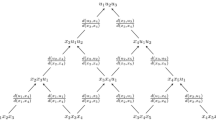Abstract
Spline function of degreem, deficiencyJ−1, i. e. inC m−J, are used in conjunction with (Gaussian) quadrature rules to construct algorthms for the numerical solution of a general Volterra integral equation of the second kind. For a givenm, the method is of order (m+1) and, in general, requires 0(N) evaluations of the kernel. This is in sharp contrast to the 0(N 2) evaluations required by hitherto known methods.
It is shown that the method for spline functions with full continuity (J=1) is numerically unstable for allm>2. However, stability is established forJ=m, m−1, for allm. Furthermore, form=3,J=1, it is demonstrated that by appropriately modifying the original method, a whole family of stable methods is obtained.
Zusammenfassung
Zur Konstruktion von Algorithmen zur numerischen Lösung einer allgemeinen Volterraschen Integralgleichung zweiter Art werden Splinefunktionen vom Gradem und der DefizienzJ−1, d. h. inC m−J, zusammen mit Gaußschen Quadraturformeln benutzt. Die Methode ist, für gegebenesm, von der Ordnung (m+1), und sie erfordert im allgemeinen 0(N) Auswertungen des Kerns. Die bisher bekannten Methoden erfordern 0(N 2) Auswertungen.
Es wird gezeigt, daß die Methode für Splinefunktionen mit voller Stetigkeit (J=1) numerisch instabil ist für allem>2. Dagegen wird die Stabilität bewiesen fürJ=m, m −1 undm beiliebig. Weiter wird fürm=3,J=1 gezeigt, daß bei geeigneter Modifikation der ursprünglichen Methode eine ganze Familie stabiler Methoden gewonnen werden kann.
Similar content being viewed by others
References
Linz, P.: The numerical solution of Volterra integral equations by finite difference methods. Tech. Summary Rep. No. 825, Maths. Research Centre, U. S. Army, University of Wisconsin, 1968.
Hung, Hing-Sum: The numerical solution of differential and integral equations by spline functions. Tech. Summary Rep. No. 1653, Maths. Research Centre, U.S. Army, University of Wisconsin, 1970.
Brunner, H.: The solution of non-linear Volterra integral equations by piecewire polynomials. Proc. Manitoba Conference on Numer. Maths., Winnipeg, 1971, pp. 65–78.
El Tom, M. E. A.: Application of spline functions to Volterra integral equations. J. Inst. Maths. Applics.8, 354–357 (1971).
El Tom, M. E. A.: Numerical solution of Volterra integral equations by spline functions. BIT13, No. 1, 1–7 (1973).
Keller, J. B., Olmstead, W. E.: Temperature of a non-linearly radiating semi-infinite solid. Quart. Appl. Math.29, 559–566 (1972).
El Tom, M. E. A.: Spline functions approximations to the solution of singular Volterra integral equations of the second kind. J. Inst. Maths. Applics.14, 303–309 (1974).
El Tom, M. E. A.: Hich-order spline function approximations for solutions of Volterra integral equations. Paper presented at the Conf. Numer. Analysis, Dublin, Ireland, 29 July – 2 August, 1974.
Krylov, V. I.: Approximate calculation of integrals. New York: Macmillan 1962.
El Tom, M. E. A.: On the numerical stability of spline function approximations to solutions of Volterra integral equations of the second kind. BIT14, 136–143 (1974).
Author information
Authors and Affiliations
Rights and permissions
About this article
Cite this article
El Tom, M.E.A. Efficient algorithms for volterra integral equations of the second kind. Computing 14, 153–166 (1975). https://doi.org/10.1007/BF02242314
Received:
Published:
Issue Date:
DOI: https://doi.org/10.1007/BF02242314



